The History of Housing in New England Part 5: Post World War II to the Present

Aerial view of downtown Amherst wih Boltwood Place in the upper right. Photo: Amherst Business Improvement District/Facebook
Amherst History Month by Month
By Hetty Startup
“Housing security and housing affordability are foundational to health and prosperity.” — Dr. Mark Keroack
This is the fifth and final installment in the series. Read Part 1 here, Part 2 here, Part 3 here, and Part 4 here.
The post-World War II period up to the early 1970s was a boom time for housing construction of all kinds. Its historic context may be familiar to older Indy readers; shelter was part of a strong safety-net knitting together housing, welfare, and public health; unions were fighting successfully for better wages and good working conditions; higher education was also booming, especially in New England. Specifically, the country saw some positive changes in housing policy; to wit, the 1968 Fair Housing Act made housing discrimination based on race or ethnicity illegal. This legislation is also known as the Civil Rights Act or the Housing and Urban Development Act (frequently called the HUD Act). It provided legal leverage for undermining the practice of redlining, which devalued neighborhoods in which African-Americans lived, by labelling them high-risk for mortgages.
Amherst in the late 1970s and 1980s also saw changes in local housing policy. Developments like the condominiums at Amity Place were built between 1985 and 1987 as a Planned Unit Residential District (PURD), which allowed greater density than was usual at the time. The development was built with townhouses as well as semi-detached duplexes.


Even though market-driven private developers and public-private developer partnerships had begun to dominate housing construction in New England by the 1990s, there are some worthy exceptions. In the 1990s, an Amherst-based interfaith housing association’s board of directors sold the Village Park complex that is located off North Pleasant Street and used the profits to create a new housing trust, The Interfaith Housing Corporation of Amherst. This is completely separate from the Amherst Municipal Affordable Housing Trust.
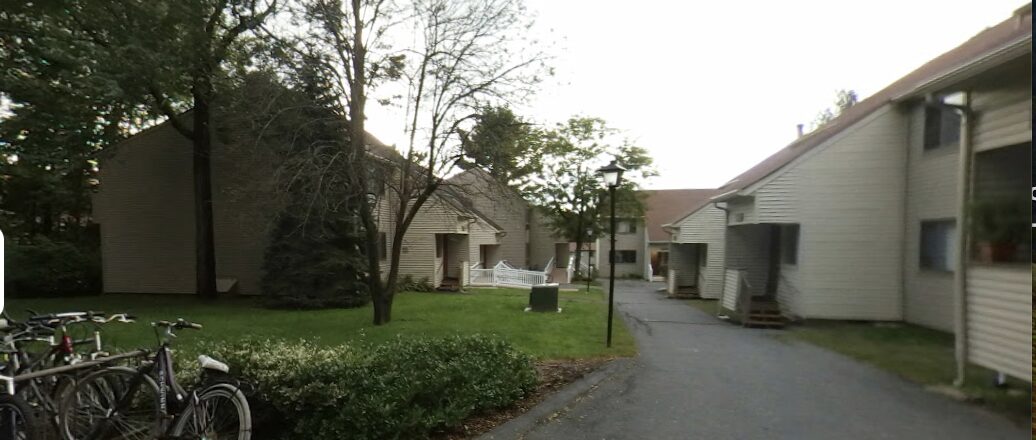
This new non-profit led to both the founding of Craig’s Doors an organization that addresses homelessness in Amherst, and also to the construction of Olympia Oaks designed by Kuhn Riddle Architects. Olympia Oaks is an award-winning development, managed by Way Finders, which helps people who are facing the very real challenges in life of finding housing. It also partners with municipal housing initiatives in our region.

Another positive social housing initiative in Amherst was the construction of Cherry Hill Co-Housing, which opened in North Amherst in 1994. Co-Housing as envisioned in Amherst is an intentional community of private homes clustered around shared space. At Cherry Hill, each attached or single-family home has traditional amenities, including a private kitchen. But there are also shared spaces, such as a 4,500-square-foot common structure that includes a large communal kitchen, dining, and social area, laundry, guest room, and recreational spaces. Neighbors also share resources like tools and lawnmowers. With 32 households of various kinds on a site of 22 acres, the community features pedestrian-friendly paths to the homes with parking at the edges. There is also a workshop and artist studio, an office building, and numerous play structures. As you drive into the development, what is striking are the open fields, the gardens, and a hen house. A garden cart has the words written on it “We are stardust, we are golden…..” Cherry Hill was one of the first co-housing communities to be built in the eastern U.S. (More information about co-housing here.)
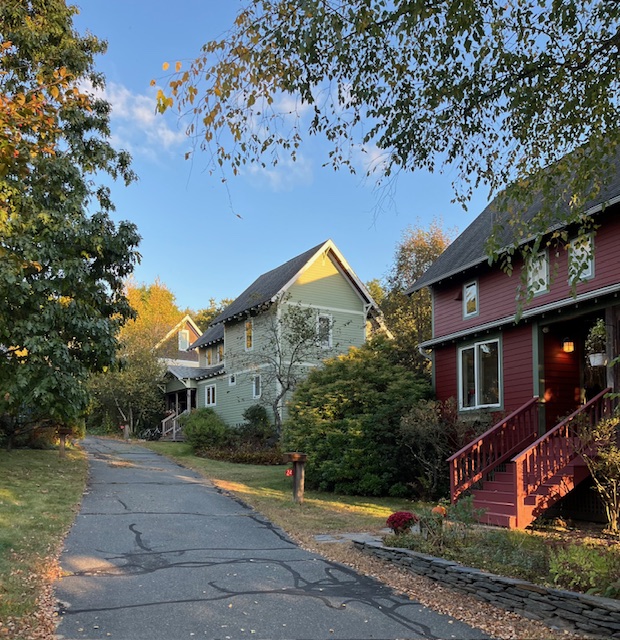
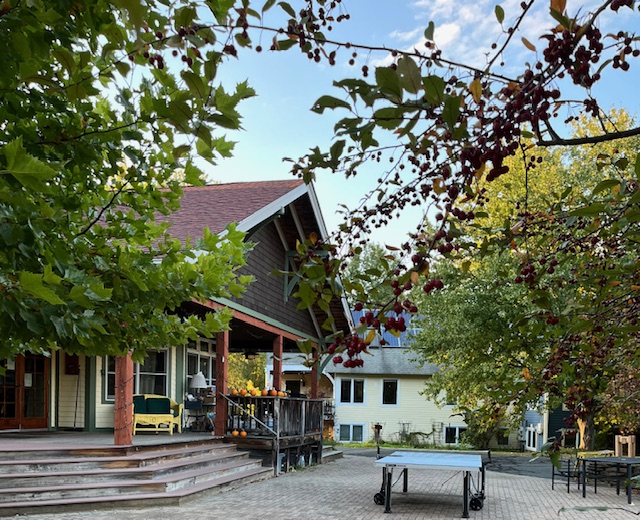
Sadly, Amherst is not exempt from YIMBY-ism. (Yes, in my backyard!). YIMBYs argue that all new housing regardless of ‘character’ or affordability is progress as it resolves a perceived crisis in housing. It appears to make sense whether demolition is required of existing housing or even entire neighborhoods. It is all in the service of supply and demand and should be left to the marketplace. Since the era of John Musante as Town Manager, Amherst has deregulated some housing development in order to encourage more housing, with little attention to affordability, for example, the first of the Archipelago developments designed by Holst Architects called Boltwood Place. For a large building at the heart of our downtown, the property offers only 12 “boutique apartments.” These exclusive spaces with high-end finishes and upscale amenities may have suggested class or sophistication. They were completed in 2011. I admire the building’s clean, spare aesthetic with restrained color palette and Scandi feel. And it is Silver LEED certified. But I may be expressing a minority opinion as it is sometimes referred to as the “fridge” and its height and block-like massing has become a blueprint of sorts for later downtown construction by this company. All of their work shares an unrelentingly minimalist appearance as seen in Kendrick Place, One East Pleasant Street, and 11-13 East Pleasant Street. It is a style that has become almost universal as well as uniform because well, duh, that’s why its called a style.
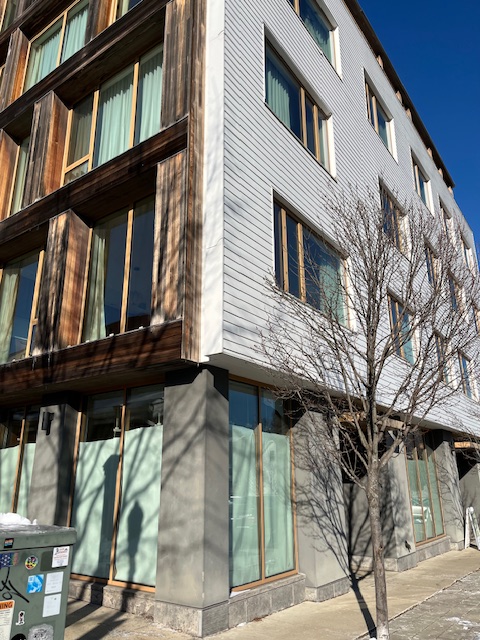
I’m more positive about a scheme that they financed and constructed on Spring Street. It is similar to Olympia Place, that Archipelago built next to Olympia Oaks on Olympia Drive. That street, close to UMass, was once intended as a Greek Life mini-campus of fraternities and sororities; only two Greek Life buildings were ever completed before the Fraternity Village was abandoned as an idea.
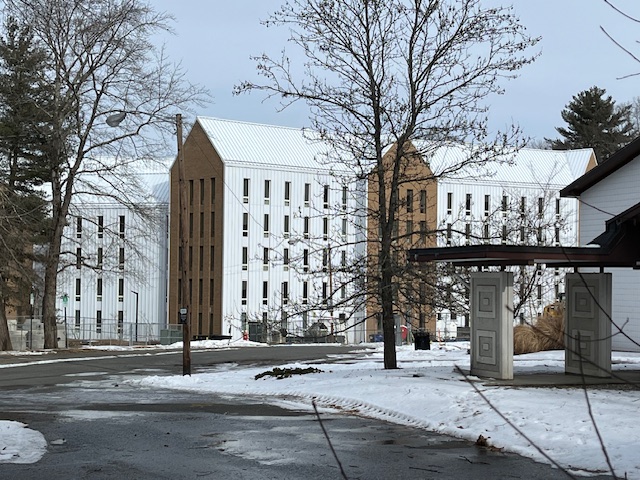
Under construction during the pandemic, Archipelago’s Spring Street residences were stalled for a while but finally opened in 2023. It is located adjacent to Grace Church and I feel it blends in beautifully to its neighborhood in terms of scale, texture and formal massing. It sits slightly uphill from the street, with plantings and a facade of smoky glass. The fact that it was planned to have a Whiskey Bar on the first floor is so suggestive of its aspirational identity.
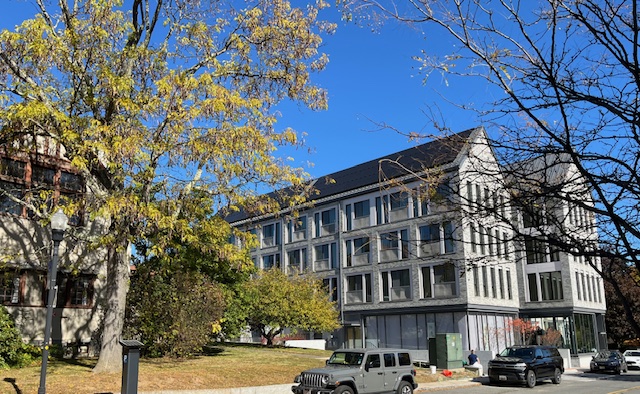
Housing Shortages
During this time, the Northeast generally and Boston in particular were seeing more pronounced housing shortages. Existing public housing stock was often considered quite old and in need of repair. During the height of the COVID pandemic in 2020-21, some federal agencies such as the Advisory Council on Historic Preservation (ACHP) have worked hard to “adopt … a [set of] streamlining measures] to make it easier and quicker to rehabilitate… federally-owned and federally-funded housing units.” These included units managed by the Department of Housing and Urban Development (HUD), the Department of Defense, the Department of Veterans Affairs, and the Department of Agriculture, with a clear path to upgrad[ing] existing housing… mak[ing] it more energy efficient, hazard-free, and accessible to people with disabilities.” ACHP has noted that upgrades have included many types of “interior rehab work, energy efficiency and water-efficiency …of mechanical/electrical/plumbing systems, ADA compliance features like ramps, lead paint and asbestos remediation, and other routine maintenance necessary to keep millions of housing units …in safe and habitable condition.”
Since 2023 solar energy installations on existing buildings have been possible and there have been projects that have installed/are installing “active transportation” elements (bike lanes and bus shelters) that help connect people and neighborhoods. There has also been an attempt to lower the number of vacancies in Massachusetts’ federally supported social housing stock so that the waitlist is not so long. Addressing a different sort of impediment to housing New Englanders is a new awareness about the words we have historically used to talk about it. For example, some cities in New England, like New Haven, CT, have worked to avoid the usually negative connotations of the word “projects” so that individuals and families can benefit from low-cost housing without, or with less, stigma.
Locally, another organization came forward in 2014 to create more affordable housing called the Amherst Community Land Trust (ACLT). ACLT is a private, non-profit, 501(c)3 that was created by Amherst residents and is still staffed entirely by volunteers. The two major elements in its mission are the support of affordable home ownership and maintaining the family character and economic diversity of Amherst’s residential neighborhoods. It supports affordability using a model of shared ownership, with ACLT holding title to the land and the resident owning the home with an inexpensive long-term lease for the land. At the time of purchase, homeowners have to meet income qualifications of no more than 80% of area annual median income (AMI). In linking affordable homeownership with existing residential neighborhoods, ACLT is unique among local housing agencies in our area. ACLT seeks to sustain residential neighborhoods by assuring a continuity of individual and family homeownership. Their latest project is to renovate an historic rental property at 174 Amity St, an 1840 Greek Revival home (in a local historic district) into an owner occupied duplex. They are partnering with Pioneer Valley Habitat for Humanity to plan the development.
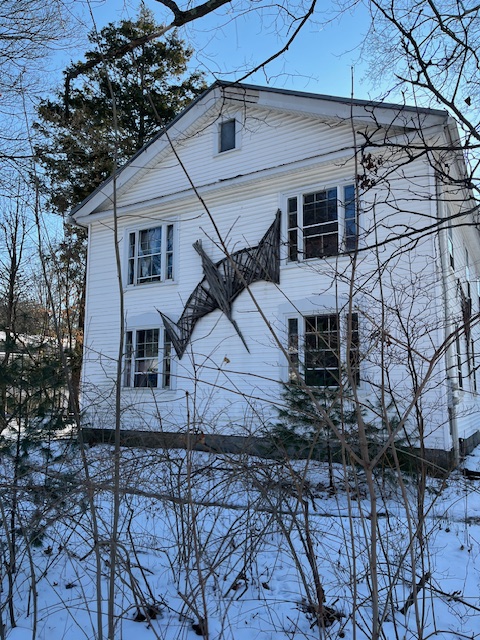
But what is primarily being built now for housing stock is not affordable (or is only affordable to a small percentage of people), and the costs of materials, labor, and land are said to be so high that this is the only way to make an acceptable profit. Still, there are some positive bits of news. In 2023, the town of Amherst partnered with Valley Community Development Corporation to build East Gables, at 132 Northampton Road. Valley Community Development Corporation is a HUD-approved housing counseling agency. East Gables is located near the Amherst College playing fields. Despite some early resistance from neighbors, the housing project, which contains 28 studio apartments, has been a success (see also here) and helps provide a much-needed element in the mix of local home offerings. “We are struck by the number of tenants who were homeless and working full-time jobs, many of them in Amherst and Hadley,” said Laura Baker, Valley CDC’s real estate development director. “Even with full-time employment, they weren’t able to afford local rents.”Housing for the homeless is also planned at the site of the old VFW building on Main Street.
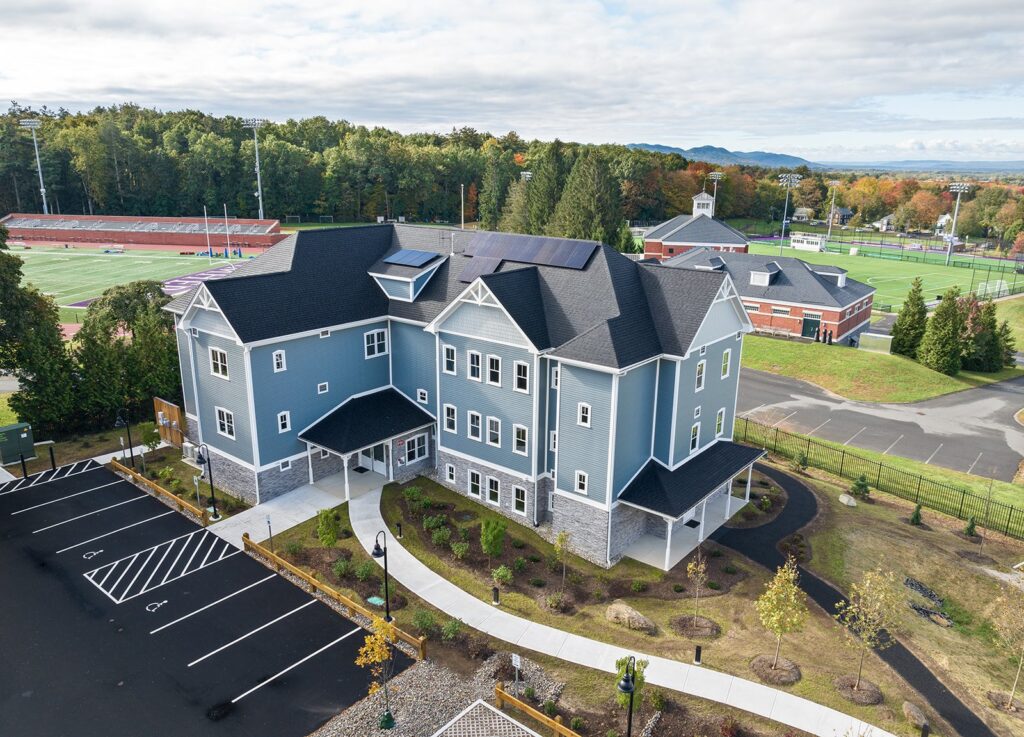
One type of social housing that could be seen as vernacular in terms of its design and origins are mobile or modular homes, a precursor to the trendy “tiny houses” of our own era. Mobile homes in the last half of the 20th century have long been considered some of the last remaining affordable home ownership options in the U.S., and there is a growing movement for mobile home owners to buy the properties that their homes depend on.
Tiny houses can also offer efficient, affordable possibilities for workforce housing. In Dover, New Hampshire, near the Piscataqua River, a local employer who wanted to ensure a sustainable group of employees for two local businesses, built 44 small homes not far from Durham and Portsmouth.
But rents have continued to increase for affordable as well as market-rate housing.
UMass played a role in the tiny house trend recently, with its PaperHouse experiment on North East Street. This is a modular, 500-square-foot, net-zero, low-carbon house built by students in the UMass DesignBuild program; the program is a joint effort between UMass’s Building and Construction Technology Program and Department of Architecture, and the Five College Architectural Studies Program.
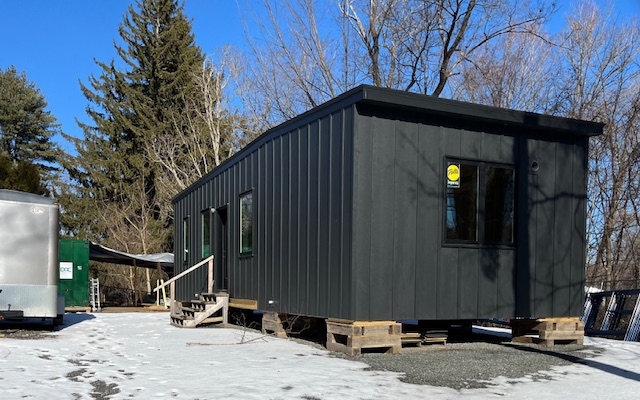
Amherst needs to continue to address the local affordable housing shortage by encouraging ADUs (Accessory Dwelling Units), which help diversify our housing stock. This is slowly happening and the Commonwealth recently mandated that an ADU equal to or less than 900 square feet can now be approved solely at the discretion of the town’s building commissioner, based on a streamlined application, and, even more importantly for Amherst, that owner occupancy (and management) of either structure is no longer needed. Amherst allows ADUs up to 1,000 square feet.
Save the date for a meeting in town, February 18 about housing. “The Town of Amherst invites community members to participate in an upcoming Housing Scenario Workshop on Tuesday, February 18, 2025, to share input that will help shape the future of housing in Amherst. The Town is updating its Housing Production Plan (HPP) to chart a path toward addressing the housing needs of low- and moderate-income people in the Town. Housing production plans are vital frameworks that consist of three key elements including: 1) Comprehensive Housing Needs Assessment, 2) Affordable Housing Goals, and 3) Implementation Strategies. The upcoming workshop will be an initial discussion regarding implementation strategies, which are essential for translating plans into action. Participants are encouraged to access a draft of the needs assessment and relevant materials pertaining to the goals online at: www.amherstma.gov/HPP.”
Read previous Amherst History Month by Month columns here.

Cmon Hetty – this is a lot more opinion than history. We should be breaking down barriers.
Subjective negative thoughts about what necessary housing investments look like ? Opinion. Not history
All housing development is market driven. Even affordable. Even public private and non profit partnerships. Why the hierarchy ? The value judgements ?
The town didn’t experience zoning changes. Towns people proactively voted changes in. We are not bystanders.
Post WWII ranches in the Hartman Drive neighborhood were market affordable
Then umass grew and the town got scared
What made housing in amherst unaffordable? Anti-growth large lot zoning. 100’ circle requirements. Super stretch codes. Materials. Extreme red tape and permitting costs. Lack of developable land due to 1/3 of town being institutional and 1/3 conserved and 1/3 developed.
I agree with the last entry, I had been thinking the same thing for 43 years, since I was the age of 20. Especially the last paragraph, and particularly the last sentence. I would point out that we all want good education, but we have invested an incredible amount into our system, the vast majority paid with property tax, a regressive tax, a tax that favors the rich and punishes the poor. Especially a system with a nine to one student to teacher ratio like the one we have. When you put that money into schools that in turn pushes up property values even higher, because everybody wants to live here. And our neighbors in other towns do without. If you don’t believe property taxes are damaging you can read a guest essay printed in The New York Times last April, “It’s Time to End the Quiet Cruelty of Property Taxes” (link below), Andrew Karhl, University of Virginia. He also wrote a book entitled, “The Black Tax”, available at the library.
https://www.nytimes.com/2024/04/11/opinion/property-taxes-racism-inequality.html
I am adding this link about a not-for-profit group advocating for housing in MA. https://www.abundanthousingma.org/howtoguidelaunch/?emci=93dec843-f5e7-ef11-90cb-0022482a94f4&emdi=5085af93-fee7-ef11-90cb-0022482a94f4&ceid=9575&fbclid=IwY2xjawIhq79leHRuA2FlbQIxMQABHRvjenu6bJz9snH18x2i-TT17nxQ0SI5AfQyb-LGvNg7Ud2JApKYFrDMMg_aem_9-JUDe7_i8Ca-AbCeQFjiA
For another perspective on housing, it is worth reading Prof. Scott Galloway’s views on Linked-In, for his ‘No Malice, No Mercy’ take on the tax models and policy issues: 1. “The winning move: Go hard at zoning reform, cut red tape, and encourage development. Such a pivot could make for strange bedfellows — zoning reform means taking on environmentalists and wealthy homeowners.” 2. “Decouple housing from wealth.” and other points he makes.